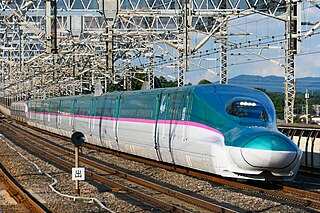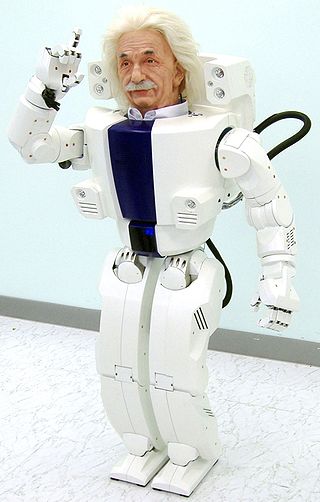
A humanoid robot is a robot resembling the human body in shape. The design may be for functional purposes, such as interacting with human tools and environments, for experimental purposes, such as the study of bipedal locomotion, or for other purposes. In general, humanoid robots have a torso, a head, two arms, and two legs, though some humanoid robots may replicate only part of the body. Androids are humanoid robots built to aesthetically resemble humans.

The Komachi (こまち) is a high-speed shinkansen service between Tokyo and Akita in Japan, operated by the East Japan Railway Company since March 1997. It is the only shinkansen service that runs on the Akita Shinkansen, and uses E6 series trains. Between Tokyo Station and Morioka, it couples with Tōhoku Shinkansen E5 series Hayabusa and formerly E2 series for E3 series respectively. After Morioka, the Komachi service continues along standard gauge tracks that were converted from narrow gauge. Because it then runs on tracks that have grade crossings, its maximum speed from Morioka to Akita is 130 km/h (80 mph), compared to 320 km/h (200 mph) on the Tohoku Shinkansen.

The Tōhoku Shinkansen (東北新幹線) is a Japanese high-speed Shinkansen rail line that runs through the more sparsely populated Tōhoku region of Japan's main island, Honshu. Operated by the East Japan Railway Company, it links Tokyo in the south to Aomori in the north, with stops in population centers such as Morioka, Koriyama, Fukushima, Hachinohe, and Sendai. With a route length of 674.9 km (419.4 mi), it is Japan's longest Shinkansen line. It also has the highest operating speeds on the Shinkansen network, reaching a maximum of 320 km/h (199 mph) on a 387.5 km (241 mi) section between Utsunomiya and Morioka.

ASIMO is a humanoid robot created by Honda in 2000. It is displayed in the Miraikan museum in Tokyo, Japan. On 8 July 2018, Honda posted the last update of ASIMO on their official page stating that it would be ceasing all development and production of ASIMO robots in order to focus on more practical applications using the technology developed through ASIMO's lifespan. It made its last active appearance in March 2022, over 20 years after its first, as Honda announced that they are retiring the robot to concentrate on remote-controlled, avatar-style, robotic technology.

The Nasuno is a train service operated on the Tōhoku Shinkansen by East Japan Railway Company in Japan. It serves all stations between Tokyo and Kōriyama, a medium-sized city approximately 225 km north of Tokyo.

EMD E-units were a line of passenger train streamliner diesel locomotives built by the General Motors Electro-Motive Division (EMD) and its predecessor the Electro-Motive Corporation (EMC). Final assembly for all E-units was in La Grange, Illinois. Production ran from May 1937, to December, 1963. The name E-units refers to the model numbers given to each successive type, which all began with E. The E originally stood for eighteen hundred horsepower, the power of the earliest model, but the letter was kept for later models of higher power.

The EMC E1 was an early passenger-train diesel locomotive developing 1,800 hp, with an A1A-A1A wheel arrangement, and manufactured by Electro-Motive Corporation of La Grange, Illinois. They were built during 1937 and 1938 for the Atchison, Topeka and Santa Fe Railway for a new generation of diesel-powered streamlined trains. 8 cab-equipped lead A units and three cabless booster B units were built. The initial three locomotives were AB pairs built to haul the Santa Fe's Super Chief diesel streamliners, while the others were built as single A units to haul shorter trains. The locomotives were diesel-electrics with two 900 hp (670 kW) Winton 201-A engines each, with each engine driving its own generator to power the traction motors. The E1 was the second model in a long line of passenger diesels of similar design known as EMD E-units. All Winton 201A-engined Santa Fe passenger units, including the E1s, were extensively rebuilt into the 80-class E8M engines in 1952–53. These were similar to production E8 models, but derated to 2,000 hp so as not to burn out the early traction (axle) motors.

The EMC EA/EB is an early passenger train-hauling diesel locomotive built from May 16, 1937, to 1938 by Electro-Motive Corporation of La Grange, Illinois for the Baltimore and Ohio Railroad. They were the first model in a long line of passenger diesels of similar design known as EMD E-units. Each locomotive unit developed 1,800 horsepower (1,300 kW) from two 900 hp (670 kW) Winton 201-A diesel engines, driving the wheels through an electric transmission—the generator driven by each engine provided current for traction motors. The locomotives were of A1A-A1A wheel arrangement—two three-axle trucks of which only the outer two axles were powered. Six two-unit 3,600 hp (2,700 kW) locomotives were produced, each consisting of a lead cab-equipped EA A unit and a cabless booster EB B unit. They were numbered 51 through 56; the A units bore the bare number and the B units the number followed by 'X'.

HUBO is a walking humanoid robot, head mounted on a life-size walking bipedal frame, developed by the Korea Advanced Institute of Science and Technology (KAIST) and released on January 6, 2005. According to Hubo's creator Prof Jun-Ho Oh and his Plenary Session at ICRA 2012 entitled Development Outline of the Humanoid Robot: HUBO II the name Hubo is simply a name, not an abbreviation.
Passive dynamics refers to the dynamical behavior of actuators, robots, or organisms when not drawing energy from a supply. Depending on the application, considering or altering the passive dynamics of a powered system can have drastic effects on performance, particularly energy economy, stability, and task bandwidth. Devices using no power source are considered "passive", and their behavior is fully described by their passive dynamics.
SIGMO is a humanoid robot designed to demonstrate the applications of passive dynamics technologies.

The P series is a series of prototype humanoid robots developed by Honda between 1993 and 2000. They were preceded by the Honda E series and followed by the ASIMO series, then the world's most advanced humanoid robots. Honda Motor's President and CEO Hiroyuki Yoshino, at the time, described Honda's humanoid robotics program as consistent with its direction to enhance human mobility.
EMIEW is a robot developed by Hitachi. Another version has also been made called EMIEW 2. EMIEW stands for Excellent Mobility and Interactive Existence as Workmate. Two EMIEWs have been made, called Pal and Chum. Hitachi stated that Pal and Chum, have a vocabulary of about 100 words, and Pal exhibited these skills by telling reporters: "I want to be able to walk about in places like Shinjuku and Shibuya in the future without bumping into people and cars". Both EMIEWs have a top speed of 6 km/h and can avoid obstacles.

The Yamabiko (やまびこ) is a high-speed Shinkansen train service operated on the Tōhoku Shinkansen between Tokyo and Morioka by East Japan Railway Company in Japan.
Honda Advanced Technology is part of Honda's long-standing research and development program focused on building new models for their automotive products and automotive-related technologies, with many of the advances pertaining to engine technology. Honda's research has led to practical solutions ranging from fuel-efficient vehicles and engines, to more sophisticated applications such as the humanoid robot, ASIMO, and the Honda HA-420 Honda-jet, a six-passenger business jet.
A MultiMode manual transmission is a type of automated manual transmission offered by Toyota. It uses a traditional manual gearbox with a computer-controlled clutch actuated by permanent magnet motors. Multimode Manual Transmission is available in the Aygo, Yaris, Corolla, Corolla Verso, Mark X and Auris in Europe, and should not be confused with Multimode Automatic Transmission, which is offered in the North American market by Toyota.
The KUKA Robot Language, also known as KRL, is a proprietary programming language similar to Pascal and used to control KUKA robots.
Picross e is a series of nonogram puzzle video games developed and published by Jupiter for the Nintendo 3DS handheld game console. It is the successor to Jupiter's Nintendo-published Picross games including the Mario's Picross series and Picross DS.


















